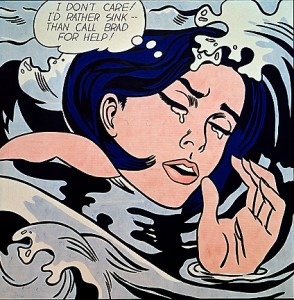Pop art, a “new art movement of the 60’s” (teh_manis, 2013) in a way signified the beginning of mass culture, as it was the form in which many artists chose to criticise the new mass mediums in which the cultures and societies around them had become so consumed. It is the presence of criticism that truly alerts us to the presence of a movement, in this case mass culture and consumerism.
The works of Roy Lichtenstein and Andy Warhol are two great examples of individuals who took their art and used it in a way to critique this mass movement. Lichtenstein’s work was “heavily influenced by both popular advertising and the comic book style.” (teh_manis, 2013) His most famous works are his collection of comic strips, which are “close but not exact copies of panels from other comic books.” (teh_manis, 2013) as exemplified through David Barsalou’s work on “deconstructing” Roy Lichtenstein’s art, as Barsalou puts the pieces together, placing the works from the original comic books that Lichtenstein copied next to Lichtenstein’s own works (Barsalou, 2015). “Instead of using the primary colors of red, yellow and blue; he uses the primary colors of a printer which are yellow, magenta and cyan. He uses think lines, bolder colors than the original, and ben-day dots just like a printer would create on paper.” All of these factors emphasise the idea of remixing and drawing from the original, as in a way pop art was the first remix, creating works from already existent work, but in this case to create a critique of mass culture, unlike today where it has become a staple of mass culture. (teh_manis, 2013)
An example of his work is Drowning Girl (1963), which came from a story from DC Comics’ Secret Hearts #83 (teh_manis, 2013):
An example of the ben-day dots that Lichtenstein used in his works:
When Lichtenstein first published his works, he was met with much criticism as many in the media questioned his originality. “In 1964, Life magazine published an article titled ‘Is He the Worst Artist in the U.S.?’ Lichtenstein responded to this claim and others with ‘The closer my work is to the original, the more threatening and critical the content’.” (teh_manis, 2013). The media continued to criticise his works, even asking the question ‘is this art?’. The attention to detail created by hand is no small feat, but it was created for the purpose of critiquing the climate of art and culture at the time and made you contemplate your current situation. By any definition it is art, just as John Cage created the ‘sound of silence’.
Another great example of the pop art movement of the 60’s is Andy Warhol’s work:
The “Campbell’s Soup Cans” painting by Warhol (of which the above is only a segment) references and critiques the mass consumerism and culture of the 60’s.
The works from this new wave movement from the 60’s were vital to the creation of the current mass culture as well as the expression of critical views towards society through art being fostered and continually fostered now,thanks to such artists.
– teh_manis. “The Originality of Roy Lichtenstein’s Comic Panel Art”. Mar. 15th 2013. Available at: http://graphicnovel.umwblogs.org/2013/03/15/the-originality-of-roy-lichtensteins-comic-panel-art/
– Barsalou, David. “Deconstructing Roy Lichtenstein.” 2015. Available at: http://davidbarsalou.homestead.com/LICHTENSTEINPROJECT.html


![warhol-campbellsoup[1]](http://www.mediafactory.org.au/alaine-thompson/files/2015/06/warhol-campbellsoup1-1odrss3-240x300.jpg)